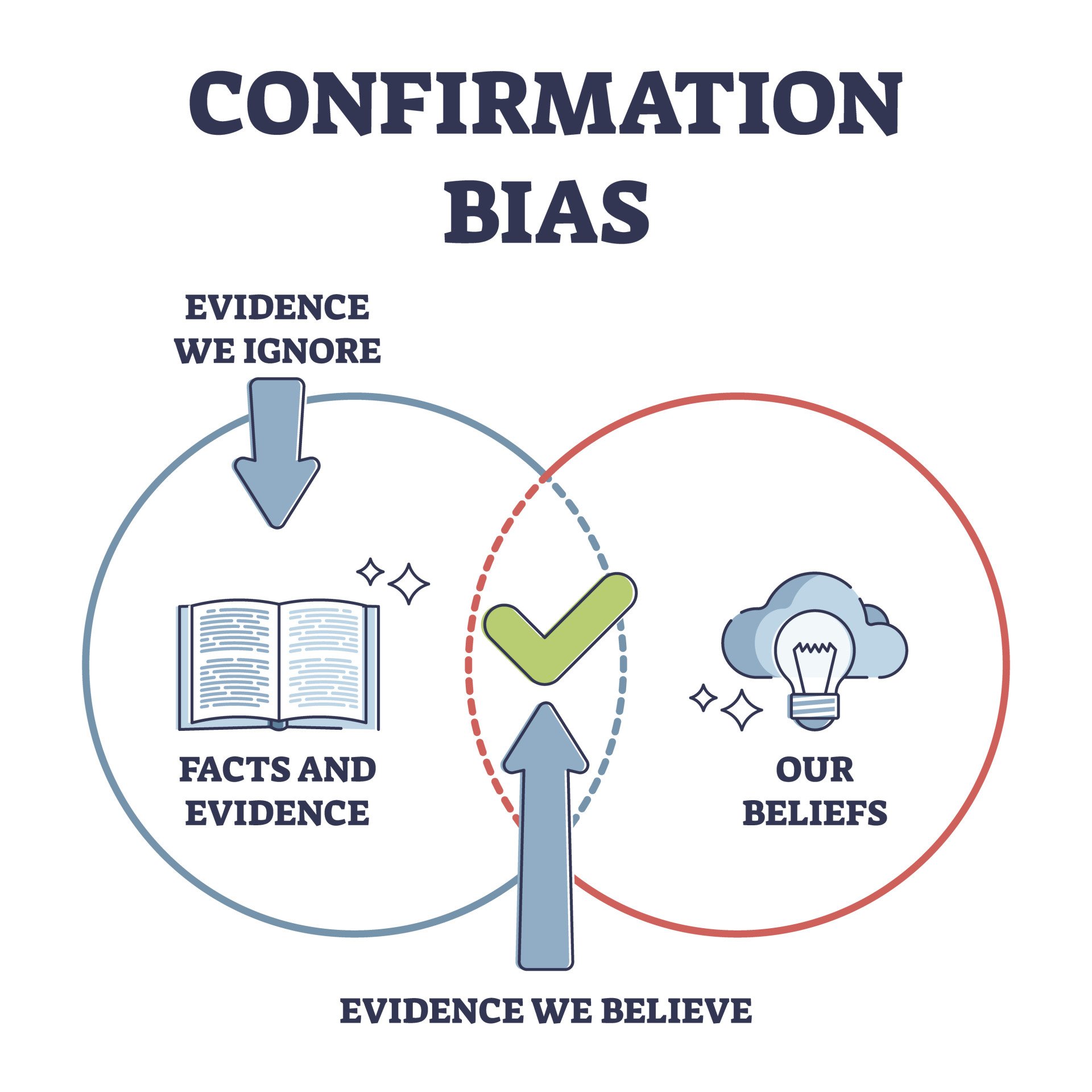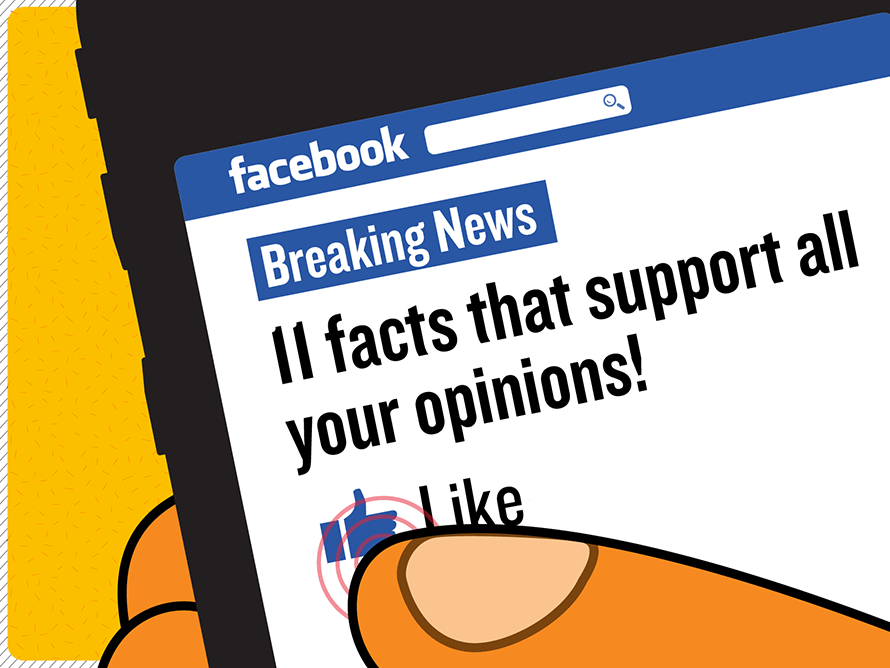On This Page:
Confirmation Bias is the tendency to look for information that supports, rather than rejects, one’s preconceptions, typically by interpreting evidence to confirm existing beliefs while rejecting or ignoring any conflicting data (American Psychological Association).
One of the early demonstrations of confirmation bias appeared in an experiment by Peter Watson (1960) in which the subjects were to find the experimenter’s rule for sequencing numbers.
Its results showed that the subjects chose responses that supported their hypotheses while rejecting contradictory evidence, and even though their hypotheses were incorrect, they became confident in them quickly (Gray, 2010, p. 356).
Though such evidence of confirmation bias has appeared in psychological literature throughout history, the term ‘confirmation bias’ was first used in a 1977 paper detailing an experimental study on the topic (Mynatt, Doherty, & Tweney, 1977).

Types
Biased Search for Information
This type of confirmation bias explains people’s search for evidence in a one-sided way to support their hypotheses or theories.
Experiments have shown that people provide tests/questions designed to yield “yes” if their favored hypothesis is true and ignore alternative hypotheses that are likely to give the same result.
This is also known as the congruence heuristic (Baron, 2000, p.162-64). Though the preference for affirmative questions itself may not be biased, there are experiments that have shown that congruence bias does exist.
For Example:
If you were to search “Are cats better than dogs?” in Google, all you would get are sites listing the reasons why cats are better.
However, if you were to search “Are dogs better than cats?” google will only provide you with sites that believe dogs are better than cats.
This shows that phrasing questions in a one-sided way (i.e., affirmative manner) will assist you in obtaining evidence consistent with your hypothesis.
Biased Interpretation
This type of bias explains that people interpret evidence concerning their existing beliefs by evaluating confirming evidence differently than evidence that challenges their preconceptions.
Various experiments have shown that people tend not to change their beliefs on complex issues even after being provided with research because of the way they interpret the evidence.
Additionally, people accept “confirming” evidence more easily and critically evaluate the “disconfirming” evidence (this is known as disconfirmation bias) (Taber & Lodge, 2006).
When provided with the same evidence, people’s interpretations could still be biased.
For example:
Biased interpretation is shown in an experiment conducted by Stanford University on the topic of capital punishment. It included participants who were in support of and others who were against capital punishment.
All subjects were provided with the same two studies.
After reading the detailed descriptions of the studies, participants still held their initial beliefs and supported their reasoning by providing “confirming” evidence from the studies and rejecting any contradictory evidence or considering it inferior to the “confirming” evidence (Lord, Ross, & Lepper, 1979).
Biased Memory
To confirm their current beliefs, people may remember/recall information selectively. Psychological theories vary in defining memory bias.
Some theories state that information confirming prior beliefs is stored in the memory while contradictory evidence is not (i.e., Schema theory). Some others claim that striking information is remembered best (i.e., humor effect).
Memory confirmation bias also serves a role in stereotype maintenance. Experiments have shown that the mental association between expectancy-confirming information and the group label strongly affects recall and recognition memory.
Though a certain stereotype about a social group might not be true for an individual, people tend to remember the stereotype-consistent information better than any disconfirming evidence (Fyock & Stangor, 1994).
For example:
In one experimental study, participants were asked to read a woman’s profile (detailing her extroverted and introverted skills) and assess her for either a job of a librarian or real-estate salesperson.
Those assessing her as a salesperson better recalled extroverted traits, while the other group recalled more examples of introversion (Snyder & Cantor, 1979).
These experiments, along with others, have offered an insight into selective memory and provided evidence for biased memory, proving that one searches for and better remembers confirming evidence.
Examples

Social Media
Information we are presented on social media is not only reflective of what the users want to see but also of the designers’ beliefs and values. Today, people are exposed to an overwhelming number of news sources, each varying in their credibility.
To form conclusions, people tend to read the news that aligns with their perspectives. For instance, new channels provide information (even the same news) differently from each other on complex issues (i.e., racism, political parties, etc.), with some using sensational headlines/pictures and one-sided information.
Due to the biased coverage of topics, people only utilize certain channels/sites to obtain their information to make biased conclusions.
Religious Faith
People also tend to search for and interpret evidence with respect to their religious beliefs (if any).
For instance, on the topics of abortion and transgender rights, people whose religions are against such things will interpret this information differently than others and will look for evidence to validate what they believe.
Similarly, those who religiously reject the theory of evolution will either gather information disproving evolution or hold no official stance on the topic.
Also, irreligious people might perceive events that are considered “miracles” and “test of faiths” by religious people to be a reinforcement of their lack of faith in a religion.
when Does The Confirmation Bias Occur?
There are several explanations why humans possess confirmation bias, including this tendency being an efficient way to process information, protect self-esteem, and minimize cognitive dissonance.
Information Processing
Confirmation bias serves as an efficient way to process information because of the limitless information humans are exposed to.
To form an unbiased decision, one would have to critically evaluate every piece of information present, which is unfeasible. Therefore, people only tend to look for information desired to form their conclusions (Casad, 2019).
Protect Self-esteem
People are susceptible to confirmation bias to protect their self-esteem (to know that their beliefs are accurate).
To make themselves feel confident, they tend to look for information that supports their existing beliefs (Casad, 2019).
Minimize Cognitive Dissonance
Cognitive dissonance also explains why confirmation bias is adaptive.
Cognitive dissonance is a mental conflict that occurs when a person holds two contradictory beliefs
and causes psychological stress/unease in a person.
To minimize this dissonance, people adapt to confirmation bias by avoiding information that is contradictory to their views and seeking evidence confirming their beliefs.
Challenge avoidance and reinforcement seeking to affect people’s thoughts/reactions differently since exposure to disconfirming information results in negative emotions, something that is nonexistent when seeking reinforcing evidence (“The Confirmation Bias: Why People See What They Want to See”).
Implications
Confirmation bias consistently shapes the way we look for and interpret information that influences our decisions in this society, ranging from homes to global platforms. This bias prevents people from gathering information objectively.
Politics
During the election campaign, people tend to look for information confirming their perspectives on different candidates while ignoring any information contradictory to their views.
This subjective manner of obtaining information can lead to overconfidence in a candidate, and misinterpretation/overlooking of important information, thus influencing their voting decision and, eventually country’s leadership (Cherry, 2020).
Recruitment and Selection
Confirmation bias also affects employment diversity because preconceived ideas about different social groups can introduce discrimination (though it might be unconscious) and impact the recruitment process (Agarwal, 2018).
Existing beliefs of a certain group being more competent than the other is the reason why particular races and gender are represented the most in companies today. This bias can hamper the company’s attempt at diversifying its employees.
Mitigating Confirmation Bias
Change in intrapersonal thought:
To avoid being susceptible to confirmation bias, start questioning your research methods, and sources used to obtain their information.
Expanding the types of sources used in searching for information could provide different aspects of a particular topic and offer levels of credibility.
- Read entire articles rather than forming conclusions based on the headlines and pictures. – Search for credible evidence presented in the article.
- Analyze if the statements being asserted are backed up by trustworthy evidence (tracking the source of evidence could prove its credibility). – Encourage yourself and others to gather information in a conscious manner.
Alternative hypothesis:
Confirmation bias occurs when people tend to look for information that confirms their beliefs/hypotheses, but this bias can be reduced by taking into alternative hypotheses and their consequences.
Considering the possibility of beliefs/hypotheses other than one’s own could help you gather information in a more dynamic manner (rather than a one-sided way).
Related Cognitive Biases
There are many cognitive biases that characterize as subtypes of confirmation bias. Following are two of the subtypes:
Backfire Effect
The backfire effect occurs when people’s preexisting beliefs strengthen when challenged by contradictory evidence (Silverman, 2011).
- Therefore, disproving a misconception can actually strengthen a person’s belief in that misconception.
One piece of disconfirming evidence does not change people’s views, but a constant flow of credible refutations could correct misinformation/misconceptions.
This effect is considered a subtype of confirmation bias because it explains people’s reactions to new information based on their preexisting hypotheses.
For example:
A study by Brendan Nyhan and Jason Reifler (two researchers on political misinformation) explored the effects of different types of statements on people’s beliefs.
While examining two statements, “I am not a Muslim, Obama says.” and “I am a Christian, Obama says,” they concluded that the latter statement is more persuasive and resulted in people’s change of beliefs, thus affirming statements are more effective at correcting incorrect views (Silverman, 2011).
Halo Effect
The halo effect occurs when people use impressions from a single trait to form conclusions about other unrelated attributes. It is heavily influenced by the first impression.
Research on this effect was pioneered by American psychologist Edward Thorndike who, in 1920, described ways officers rated their soldiers on different traits based on first impressions (Neugaard, 2019).
Experiments have shown that when positive attributes are presented first, a person is judged more favorably than when negative traits are shown first. This is a subtype of confirmation bias because it allows us to structure our thinking about other information using only initial evidence.
Learning Check
When does the confirmation bias occur?
- When an individual only researches information that is consistent with personal beliefs.
- When an individual only makes a decision after all perspectives have been evaluated.
- When an individual becomes more confident in one’s judgments after researching alternative perspectives.
- When an individual believes that the odds of an event occurring increase if the event hasn’t occurred recently.
The correct answer is A. Confirmation bias occurs when an individual only researches information consistent with personal beliefs. This bias leads people to favor information that confirms their preconceptions or hypotheses, regardless of whether the information is true.
Take-home Messages
- Confirmation bias is the tendency of people to favor information that confirms their existing beliefs or hypotheses.
- Confirmation bias happens when a person gives more weight to evidence that confirms their beliefs and undervalues evidence that could disprove it.
- People display this bias when they gather or recall information selectively or when they interpret it in a biased way.
- The effect is stronger for emotionally charged issues and for deeply entrenched beliefs.
References
Agarwal, P., Dr. (2018, October 19). Here Is How Bias Can Affect Recruitment In Your Organisation. https://www.forbes.com/sites/pragyaagarwaleurope/2018/10/19/how-can-bias-during-interviewsaffect-recruitment-in-your-organisation
American Psychological Association. (n.d.). APA Dictionary of Psychology. https://dictionary.apa.org/confirmation-bias
Baron, J. (2000). Thinking and Deciding (Third ed.). Cambridge University Press.
Casad, B. (2019, October 09). Confirmation bias. https://www.britannica.com/science/confirmation-bias
Cherry, K. (2020, February 19). Why Do We Favor Information That Confirms Our Existing Beliefs? https://www.verywellmind.com/what-is-a-confirmation-bias-2795024
Fyock, J., & Stangor, C. (1994). The role of memory biases in stereotype maintenance. The British journal of social psychology, 33 (3), 331–343.
Gray, P. O. (2010). Psychology . New York: Worth Publishers.
Lord, C. G., Ross, L., & Lepper, M. R. (1979). Biased assimilation and attitude polarization: The effects of prior theories on subsequently considered evidence. Journal of Personality and Social Psychology, 37 (11), 2098–2109.
Mynatt, C. R., Doherty, M. E., & Tweney, R. D. (1977). Confirmation bias in a simulated research environment: An experimental study of scientific inference. Quarterly Journal of Experimental Psychology, 29 (1), 85-95.
Neugaard, B. (2019, October 09). Halo effect. https://www.britannica.com/science/halo-effect
Silverman, C. (2011, June 17). The Backfire Effect . https://archives.cjr.org/behind_the_news/the_backfire_effect.php
Snyder, M., & Cantor, N. (1979). Testing hypotheses about other people: The use of historical knowledge. Journal of Experimental Social Psychology, 15 (4), 330–342.
Further Information
- What Is Confirmation Bias and When Do People Actually Have It?
- Confirmation Bias: A Ubiquitous Phenomenon in Many Guises
- The importance of making assumptions: why confirmation is not necessarily a bias
- Decision Making Is Caused By Information Processing And Emotion: A Synthesis Of Two Approaches To Explain The Phenomenon Of Confirmation Bias
When does the confirmation bias occur?
Confirmation bias occurs when individuals selectively collect, interpret, or remember information that confirms their existing beliefs or ideas, while ignoring or discounting evidence that contradicts these beliefs.
This bias can happen unconsciously and can influence decision-making and reasoning in various contexts, such as research, politics, or everyday decision-making.
What is confirmation bias in psychology?
Confirmation bias in psychology is the tendency to favor information that confirms existing beliefs or values. People exhibiting this bias are likely to seek out, interpret, remember, and give more weight to evidence that supports their views, while ignoring, dismissing, or undervaluing the relevance of evidence that contradicts them.
This can lead to faulty decision-making because one-sided information doesn’t provide a full picture.

